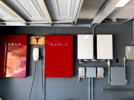Hayseed_MS
Spreader of "Endless Non Sequitur"
Only a poor choice if one does not want to spend more money. Maybe most of us don't care much. I have a Tesla plug but attached to a generic old Bosch wall unit. I suppose I see no reason to spend more money.
The is an honest question from someone who does not know electricity, but how does charging faster cost more money? Don't I pay by the kwh whether it takes 5 mins or 5 hours to fill the same spot?
Or are you talking about the cost of the charging equipment itself?



